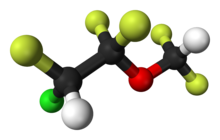Enfluran
Enfluran (2-kloro-1,1,2-trifluoroetil difluorometil eter) adalah eter terhalogenasi. Dikembangkan oleh Ross Terrell pada tahun 1963, pertama kali digunakan secara klinis pada tahun 1966. Obat ini semakin banyak digunakan untuk anestesi inhalasi selama tahun 1970-an dan 1980-an[1] tetapi tidak lagi umum digunakan.[2]

| |
|---|---|

| |
| Nama sistematis (IUPAC) | |
| (RS)-2-kloro-1-(difluorometoksi)-1,1,2-trifluoroetana | |
| Data klinis | |
| AHFS/Drugs.com | Micromedex Detailed Consumer Information |
| Kat. kehamilan | ? |
| Status hukum | ? |
| Data farmakokinetik | |
| Ikatan protein | 97% |
| Pengenal | |
| Nomor CAS | 13838-16-9 |
| Kode ATC | N01AB04 |
| PubChem | CID 3226 |
| Ligan IUPHAR | 7175 |
| DrugBank | DB00228 |
| ChemSpider | 3113 |
| UNII | 91I69L5AY5 |
| KEGG | D00543 |
| ChEBI | CHEBI:4792 |
| ChEMBL | CHEMBL1257 |
| Data kimia | |
| Rumus | C3H2ClF5O |
| SMILES | eMolecules & PubChem |
| |
Enfluran adalah isomer struktural dari isofluran. Obat ini mudah menguap, tetapi berwujud cair pada suhu kamar.
Sifat fisik
| Sifat | Nilai |
|---|---|
| Titik didih pada 1 atm | 56,5 °C |
| MAC | 1,68 |
| Tekanan uap pada 20 °C | 22,9 kPa (172 mm Hg) |
| Koefisien partisi gas—darah | 1.9 |
| Koefisien partisi gas—minyak | 98 |
Farmakologi
Mekanisme kerja anestesi umum yang tepat belum dijelaskan.[3] Enfluran bertindak sebagai modulator alosterik positif dari GABAA,[4][5][6][7] reseptor glisin, dan 5-HT3,[8][9] dan sebagai modulator alosterik negatif dari reseptor AMPA, kainat, dan NMDA,[9][10][11] serta reseptor asetilkolin nikotinik.[8]
Efek samping
Keselamatan kerja
Referensi
- ^ Niedermeyer E, Lopes da Silva FH (2005). Electroencephalography: Basic Principles, Clinical Applications, and Related Fields. Lippincott Williams & Wilkins. hlm. 1156. ISBN 978-0-7817-5126-1.
- ^ Hemmings Jr HC, Egan TD (2013). Pharmacology and Physiology for Anesthesia. doi:10.1016/C2009-0-41712-4. ISBN 9781437716795.
- ^ Perkins B (7 February 2005). "How does anesthesia work?". Scientific American.
- ^ Wakamori M, Ikemoto Y, Akaike N (December 1991). "Effects of two volatile anesthetics and a volatile convulsant on the excitatory and inhibitory amino acid responses in dissociated CNS neurons of the rat". Journal of Neurophysiology. 66 (6): 2014–2021. doi:10.1152/jn.1991.66.6.2014. PMID 1667416.
- ^ Jones MV, Brooks PA, Harrison NL (April 1992). "Enhancement of gamma-aminobutyric acid-activated Cl- currents in cultured rat hippocampal neurones by three volatile anaesthetics". The Journal of Physiology. 449: 279–293. doi:10.1113/jphysiol.1992.sp019086. PMC 1176079 . PMID 1326046.
- ^ Krasowski MD, Harrison NL (February 2000). "The actions of ether, alcohol and alkane general anaesthetics on GABAA and glycine receptors and the effects of TM2 and TM3 mutations". British Journal of Pharmacology. 129 (4): 731–743. doi:10.1038/sj.bjp.0703087. PMC 1571881 . PMID 10683198.
- ^ Lin LH, Chen LL, Zirrolli JA, Harris RA (November 1992). "General anesthetics potentiate gamma-aminobutyric acid actions on gamma-aminobutyric acidA receptors expressed by Xenopus oocytes: lack of involvement of intracellular calcium". The Journal of Pharmacology and Experimental Therapeutics. 263 (2): 569–578. PMID 1331405.
- ^ a b Perry EK, Ashton H, Young AH (2002). Neurochemistry of Consciousness: Neurotransmitters in Mind. John Benjamins Publishing. hlm. 154–. ISBN 978-1-58811-124-1.
- ^ a b Cote CJ, Lerman J, Anderson BJ (2013). A Practice of Anesthesia for Infants and Children: Expert Consult - Online and Print. Elsevier Health Sciences. hlm. 499–. ISBN 978-1-4377-2792-0.
- ^ Barash P, Cullen BF, Stoelting RK, Cahalan M, Stock CM, Ortega R (7 February 2013). Clinical Anesthesia, 7e: Print + Ebook with Multimedia. Lippincott Williams & Wilkins. hlm. 116–. ISBN 978-1-4698-3027-8.
- ^ Lin LH, Chen LL, Harris RA (March 1993). "Enflurane inhibits NMDA, AMPA, and kainate-induced currents in Xenopus oocytes expressing mouse and human brain mRNA". FASEB Journal. 7 (5): 479–485. doi:10.1096/fasebj.7.5.7681790 . PMID 7681790.